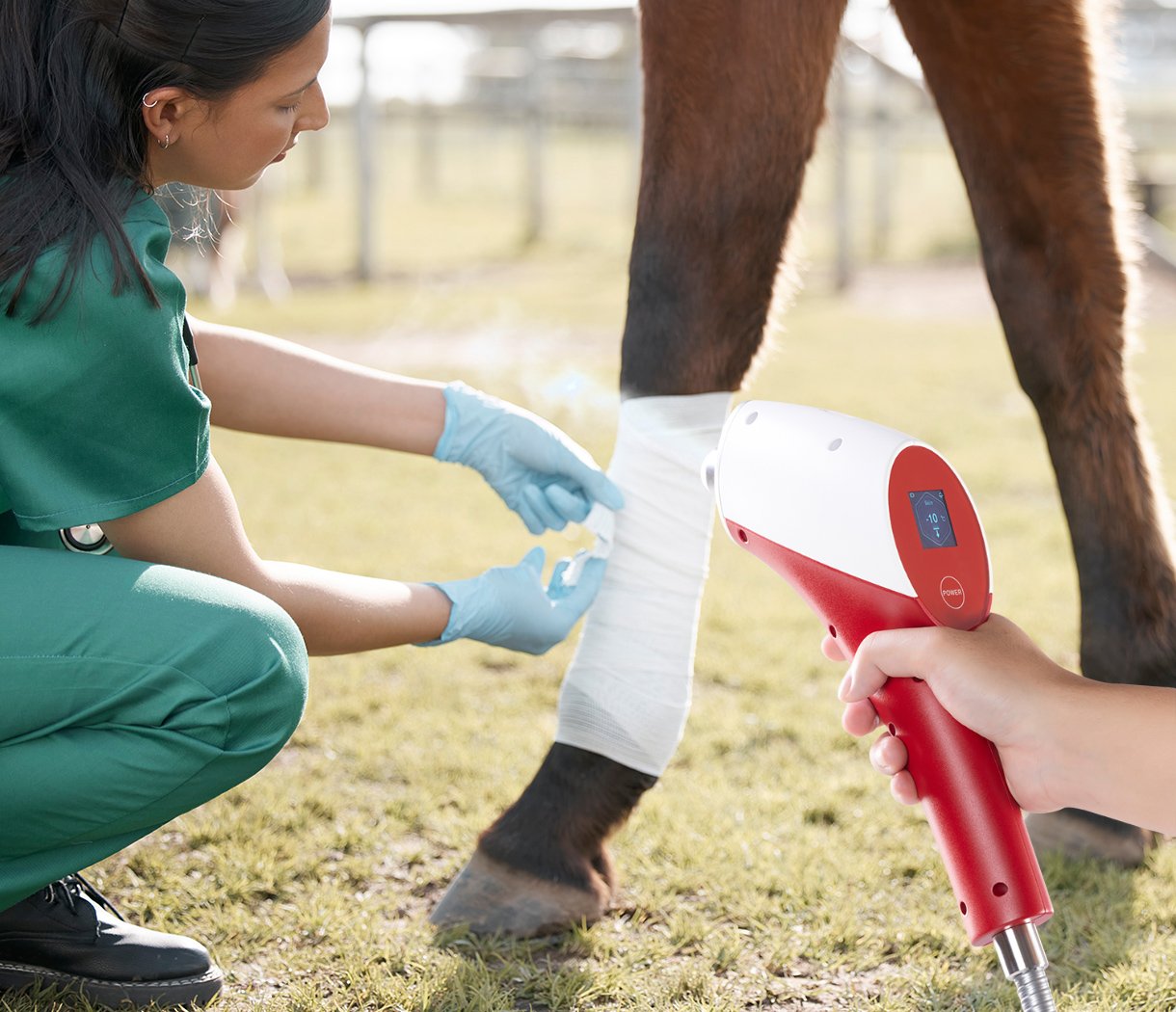The Splint Dilemma: A Common Equine Injury
Splint fractures are a frequent injury in horses, particularly those involved in rigorous training or competitive activities. These fractures occur in the lower front legs, where the splint bone runs parallel to the cannon bone. While splints are rarely life-threatening, they can cause significant pain, inflammation, and swelling, leading to lameness. Splints typically occur due to overexertion, trauma, or repetitive stress. Horses that train intensively or compete in high-impact events are especially vulnerable, but these fractures can also happen from a misstep or sudden movement. The severity of splint fractures varies, but untreated fractures can lead to prolonged healing or complications. CO2 cryotherapy offers a cutting-edge, non-invasive treatment to accelerate healing and reduce pain associated with these splints injuries.
Cryotherapy’s Cool Powers: What is CO2 Cryotherapy?
CO2 cryotherapy is an advanced treatment method using carbon dioxide in either its solid or liquid form to cool targeted areas of the body rapidly. When applied to injured areas like fractured splints, the therapy numbs the affected tissues and reduces swelling.
Unlike traditional cold therapies like ice packs, CO2 cryotherapy provides deeper, more effective cooling. The CO2 gas is applied in a controlled manner, freezing the skin and underlying tissues. This causes vasoconstriction, reducing blood flow to the injury site and alleviating pain and inflammation. The result is a quicker and more effective response, making it ideal for treating fractures and other musculoskeletal injuries in horses.
How CO2 Cryotherapy Heals
The process of CO2 cryotherapy involves rapid cooling followed by a warming phase. When CO2 is applied to the injury, the intense cold triggers vasoconstriction, reducing blood flow and minimizing swelling. This cooling effect immediately alleviates pain and inflammation.
Once the treatment ends and the area begins to warm, the blood vessels dilate (vasodilation), enhancing circulation. This allows oxygen-rich blood to flow back into the treated tissues, supplying vital nutrients and accelerating recovery. This two-phase process—cooling followed by warming—stimulates tissue repair, reduces inflammation, and speeds up recovery time. It’s an effective, non-invasive approach to healing fractured splints and other injuries.
Faster, Stronger, Better Effects
CO2 cryotherapy offers several key benefits for horses with fractured splints. First and foremost, it reduces inflammation. The cooling phase of cryotherapy causes immediate vasoconstriction, which helps control swelling and alleviates pain in the affected area. This benefit is crucial for horses suffering from painful splint fractures.
Pain relief is another major advantage of CO2 cryotherapy. The deep cooling effect numbs the area almost instantly, in 10 seconds, offering immediate comfort to the horse. This not only enhances the horse’s quality of life but also reduces stress and discomfort during recovery.
Moreover, CO2 cryotherapy accelerates the healing process. The warming phase enhances circulation, bringing fresh blood to the damaged tissues and speeding up tissue repair. With this increased blood flow, the horse’s recovery time is significantly shortened compared to traditional treatment methods.
Cryotherapy is also a non-invasive treatment option, requiring no surgery or medication, which reduces the risks associated with more invasive procedures. It’s a safe and effective treatment that helps prevent complications, such as further injury or re-injury, by promoting faster healing.
Keep Your Horse on Track: Post-Cryotherapy Care and Recovery Tips
After CO2 cryotherapy of fractured splints, it’s essential to allow your horse sufficient time to rest and recover. Refrain from putting the horse through strenuous activities for a few days after treatment to avoid straining the healing tissues. Overexertion too soon could hinder recovery.
Depending on the severity of the injury, additional cryotherapy sessions may be necessary. Work with your veterinarian to develop a customized treatment plan. In some cases, follow-up treatments can help ensure a full recovery.
Proper nutrition also plays a vital role in recovery. Ensure your horse is consuming a balanced diet that supports tissue repair and muscle recovery. Consult your vet to determine if any additional supplements are necessary to speed up healing.
Physical therapy may complement cryotherapy treatments, but any exercise or movement should be performed under the guidance of a professional to avoid overloading the injured area.
Lastly, keep an eye on the treated area for any signs of complications such as infection, unusual swelling, or persistent pain. Consult your vet if any concerning symptoms arise.



